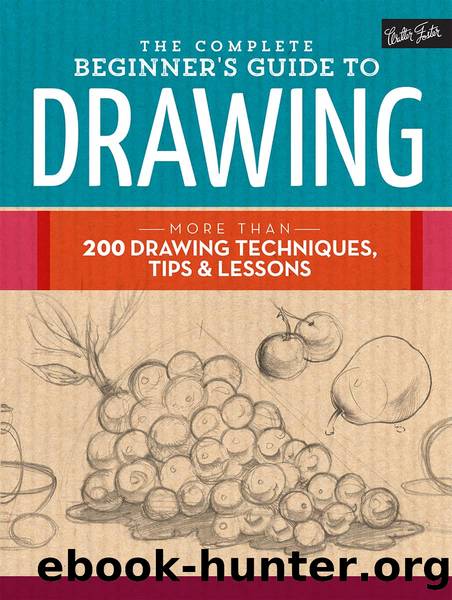The Complete Beginnerâs Guide to Drawing by Walter Foster Publishing

Author:Walter Foster Publishing
Language: eng
Format: epub
Publisher: Walter Foster Publishing
Published: 2016-06-15T00:00:00+00:00
Step 5 At this stage, add volume to the dogâs form, defining it with a few light strokes along the edges of the white fur. Now shade the far hind leg and left cheek by covering those areas with more strokes. Next go over the dark fur with a softer pencil and thinner, darker strokes, applying denser strokes toward the edges to suggest form. Finish the piece by adding the final details and shading to the nose, mouth, eyes, and inner ears.
COMPARING THE PUPPY AND THE DOG
Young puppies and full-sized dogs have the same features but in different proportions. Proportion refers to the proper relation of one part to another or to the wholeâparticularly in terms of size or shapeâand it is a key factor in achieving a good likeness. A puppy isnât just a small dog. Although a puppy has all the same parts as its adult counterpart, the puppyâs body appears more compact than the dogâsâand its paws, ears, and eyes seem much larger in proportion to the rest of its body. In contrast, the adult dog seems longer, leaner, and taller. Its muzzle appears larger in proportion to the rest of its body, and its teeth are noticeably bigger. Keeping these proportional differences in mind and incorporating them in your drawings will help you make your artwork look convincingly realistic.
Download
This site does not store any files on its server. We only index and link to content provided by other sites. Please contact the content providers to delete copyright contents if any and email us, we'll remove relevant links or contents immediately.
The Art of Boudoir Photography: How to Create Stunning Photographs of Women by Christa Meola(18494)
Red Sparrow by Jason Matthews(5342)
Harry Potter 02 & The Chamber Of Secrets (Illustrated) by J.K. Rowling(3610)
In a Sunburned Country by Bill Bryson(3463)
Drawing Cutting Edge Anatomy by Christopher Hart(3432)
Figure Drawing for Artists by Steve Huston(3356)
Harry Potter and the Prisoner of Azkaban (Book 3) by J. K. Rowling(3274)
The Daily Stoic by Holiday Ryan & Hanselman Stephen(3208)
Japanese Design by Patricia J. Graham(3088)
The Roots of Romanticism (Second Edition) by Berlin Isaiah Hardy Henry Gray John(2863)
Make Comics Like the Pros by Greg Pak(2833)
Stacked Decks by The Rotenberg Collection(2788)
Draw-A-Saurus by James Silvani(2628)
Harry Potter and the Deathly Hallows (7) by J.K. Rowling(2625)
Tattoo Art by Doralba Picerno(2576)
On Photography by Susan Sontag(2553)
Churchill by Paul Johnson(2489)
The Daily Stoic by Ryan Holiday & Stephen Hanselman(2436)
Foreign Devils on the Silk Road: The Search for the Lost Treasures of Central Asia by Peter Hopkirk(2416)
